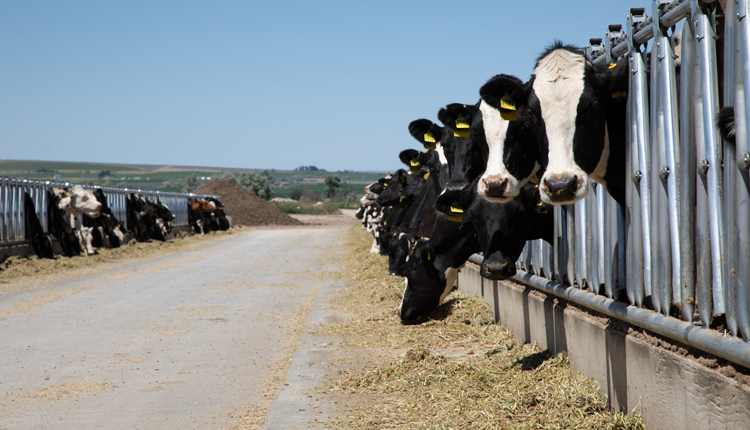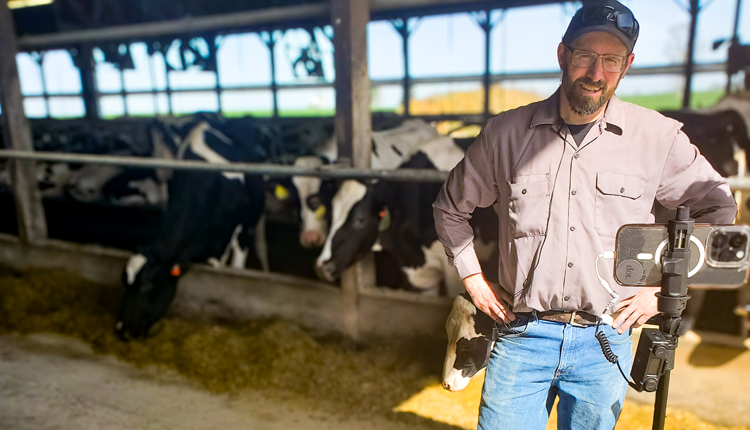Cows that do not adapt to the negative energy balance experienced after calving are candidates for developing hyperketonemia, commonly knows as ketosis. Cows that are ketotic in early lactation lose milk yield and are at higher risk for other post-partum diseases, potentially setting them up for early removal from the herd.
Ketosis is diagnosed by measuring the ?-hydroxybutyric acid (BHBA) ketone bodies circulating in the blood. The best way to test for ketosis is to have serum BHBA measured at a laboratory. Although not too expensive or difficult, some farms would like to identify the disease with a cowside test. Garret Oetzel, D.V.M. of the University of Wisconsin-Madison School of Veterinary Medicine, explains ketosis testing options in his paper, "On-farm ketosis monitoring."
There are methods for cowside ketosis testing, but their reliability is variable. The accuracy of a cowside ketosis test is compared to the standard laboratory test in order to determine their sensitivity and specificity. Sensitivity is the percent of cows identified as ketotic that are truly ketotic. Specificity is the proportion of cows identified as negative that are truly negative.
Some people are able to smell ketones that are excreted in a cow's breath. The specificity of this method is very high (about 95 percent) so if the smell is present the cow is very likely to be ketotic. Unfortunately, even those able to smell ketones are only 50 percent sensitive in their ability to diagnose ketosis. This makes the smell test too inaccurate to be the only form of ketosis detection.
The traditional cowside test for ketosis is a urine dipstick, which measures urine acetoacetate concentrations. Urine dipsticks have very good sensitivity (95 percent), which means they rarely give out false positives. However, sensitivity is at about 80 percent, so 20 percent of ketotic cows are missed. The biggest challenge with the urine dipstick is obtaining a quality urine sample.
The traditional milk test is a powder that measures milk acetoacetate. For this test, you mix a small amount of milk with the powder and then interpret the color change. This test has excellent specificity (98 percent) but poor sensitivity (35 percent), and because it misses a majority of ketotic cows it should not be used as a sole cowside test.
Another cowside milk test is the milk BHBA strip test. These strips take a room temperature milk sample and must be read one minute after dipping the strip. This method has moderately good specificity (83 percent) and sensitivity (82 percent).
According to Oetzel, the best cowside test for diagnosing ketosis is the Precision Xtra meter (Abbott Laboratories). It is 90 to 97 percent sensitive and 94 to 98 percent specific. This meter was designed to measure either whole blood BHBA or whole blood glucose in humans, but it is excellent at measuring whole blood BHBA in cows. This cowside test is accurate enough to estimate herd prevalence for ketosis. The meter and test strips can be purchased through most pharmacies or veterinary clinics.
Register here. Watch archived webinars here.

The author is an associate editor and covers animal health, dairy housing and equipment, and nutrient management. She grew up on a dairy farm near Plymouth, Wis., and previously served as a University of Wisconsin agricultural extension agent. She received a master's degree from North Carolina State University and a bachelor's from University of Wisconsin-Madison.
Ketosis is diagnosed by measuring the ?-hydroxybutyric acid (BHBA) ketone bodies circulating in the blood. The best way to test for ketosis is to have serum BHBA measured at a laboratory. Although not too expensive or difficult, some farms would like to identify the disease with a cowside test. Garret Oetzel, D.V.M. of the University of Wisconsin-Madison School of Veterinary Medicine, explains ketosis testing options in his paper, "On-farm ketosis monitoring."
There are methods for cowside ketosis testing, but their reliability is variable. The accuracy of a cowside ketosis test is compared to the standard laboratory test in order to determine their sensitivity and specificity. Sensitivity is the percent of cows identified as ketotic that are truly ketotic. Specificity is the proportion of cows identified as negative that are truly negative.
Some people are able to smell ketones that are excreted in a cow's breath. The specificity of this method is very high (about 95 percent) so if the smell is present the cow is very likely to be ketotic. Unfortunately, even those able to smell ketones are only 50 percent sensitive in their ability to diagnose ketosis. This makes the smell test too inaccurate to be the only form of ketosis detection.
The traditional cowside test for ketosis is a urine dipstick, which measures urine acetoacetate concentrations. Urine dipsticks have very good sensitivity (95 percent), which means they rarely give out false positives. However, sensitivity is at about 80 percent, so 20 percent of ketotic cows are missed. The biggest challenge with the urine dipstick is obtaining a quality urine sample.
The traditional milk test is a powder that measures milk acetoacetate. For this test, you mix a small amount of milk with the powder and then interpret the color change. This test has excellent specificity (98 percent) but poor sensitivity (35 percent), and because it misses a majority of ketotic cows it should not be used as a sole cowside test.
Another cowside milk test is the milk BHBA strip test. These strips take a room temperature milk sample and must be read one minute after dipping the strip. This method has moderately good specificity (83 percent) and sensitivity (82 percent).
According to Oetzel, the best cowside test for diagnosing ketosis is the Precision Xtra meter (Abbott Laboratories). It is 90 to 97 percent sensitive and 94 to 98 percent specific. This meter was designed to measure either whole blood BHBA or whole blood glucose in humans, but it is excellent at measuring whole blood BHBA in cows. This cowside test is accurate enough to estimate herd prevalence for ketosis. The meter and test strips can be purchased through most pharmacies or veterinary clinics.
Register here. Watch archived webinars here.

The author is an associate editor and covers animal health, dairy housing and equipment, and nutrient management. She grew up on a dairy farm near Plymouth, Wis., and previously served as a University of Wisconsin agricultural extension agent. She received a master's degree from North Carolina State University and a bachelor's from University of Wisconsin-Madison.











